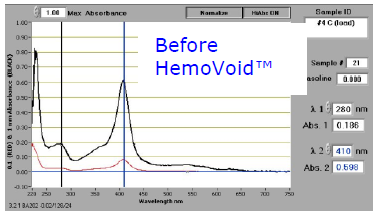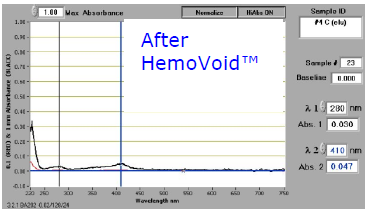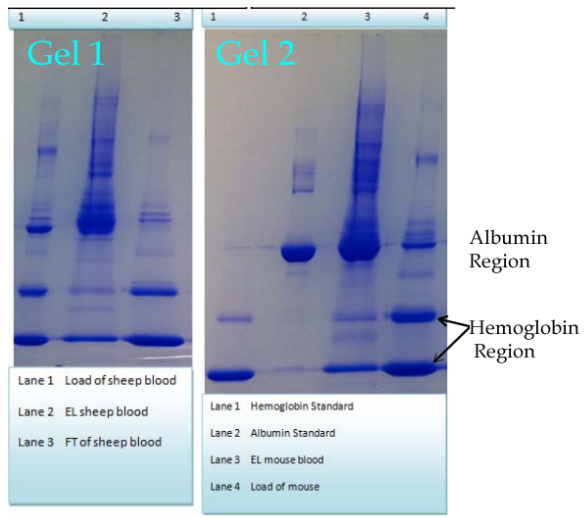Hemoglobin Depletion plus Protein Enrichment from blood card
본문
|
HemoVoid™ - Blood Card Reagent Hemoglobin Depletion Plus Protein Enrichment From Blood Card
Hemoglobin is a common contaminant from whole blood. The HemoVoid™ Blood Card protocol was designed to substantially reduce the presence of hemoglobin and its associated interference with many serum protein analytes. HemoVoid™ Blood Card is a silica based polyelectrolyte matrix, removes hemoglobin from dried whole blood card samples. The HemoVoid™ protocol uses mild buffers; the protocol conditions areso gentle that native enzyme activity is retained in elution fractions.
Features • Hemoglobin voids in flow-through >98%, with <30 minute bind/wash/elute protocol • Hemoglobin removal from whole blood lysates extracted from dried blood cards • Hemoglobin removal from frozen and fresh whole blood • Blood proteins and enzymes are enriched for potential biomarker and proteomic studies. • Disposable, cost-effective hemoglobin depletion sample preparation protocol • Removes hemoglobin from whole blood of diverse species including human, mice, sheep, bovine, goat, rat, etc.
Hemovoid Blood Card Research Applications
The HemoVoid™ Blood Card produces enriched proteins free of hemoglobin which are used for biomarkers and protein analysis(B). The hemoglobin enriched filtrate could have hemoglobin variants, hemoglobin binding proteins or other analytes optimal for biomarker studies(A).
Abs at 410 nm shows presence of hemoglobin. Proteins extracted from dried blood card show high hemoglobin concentration.
After HemoVoid™ treatment, hemoglobin is severely depleted.
References Human Red Blood Cells (RBC) HemoVoid™ On Bead Digestion Application Work On RBC (PDF) by Irene Granlund, Umeå University
Red Blood Cells, Plasmodium extracts Machado, Patrícia Isabel Pires. Pyruvate kinase and glucose-6-phosphate dehydrogenase deficiencies and their association with malaria–population genetics and proteomic studies. Diss. Universidade do Porto, 2013.
Walpurgis, Katja, et al. "Effects of gamma irradiation and 15 days of subsequent ex vivo storage on the cytosolic red blood cell proteome analyzed by 2D DIGE and Orbitrap MS." PROTEOMICS-Clinical Applications (2013).
P. Falciparum Clone 3D7 Cultured In Human Erythrocytes Lasonder E, Green JL, Camarda G, Talabani H, Holder AA, Langsley G, Alano P. The Plasmodium falciparum schizont phospho-proteome reveals extensive phosphatidylinositol and cAMP-Protein Kinase A signalling. J Proteome Research. 2012;
Red Blood Cell Lysate Barasa, Benjamin, and Monique Slijper. "Challenges for red blood cell biomarker discovery through proteomics." Biochimica et Biophysica Acta (BBA)-Proteins and Proteomics 1844.5 (2014): 1003-1010. Lange, Philipp F., Pitter F. Huesgen, Karen Nguyen, and Christopher M. Overall. "Annotating N termini for the Human Proteome Project: N termini and Nα-acetylation status differentiate stable cleaved protein species from degradation remnants in the human erythrocyte proteome." Journal of proteome research (2014). Katja Walpurgis, Maxie Kohler, Andreas Thomas et al.Validated hemoglobin-depletion approach for red blood cell lysate proteome analysis by means of 2D-PAGE and Orbitrap MS.Electrophoresis.2012; Mizukawa, B., George, A., Pushkaran, S. et al. Cooperating G6PD mutations associated with severe neonatal hyperbilirubinemia and cholestasis.Pediatric Blood Cancer.2011;56: 840-842. Sudha Neelam, David G Kakhniashvili, Stephan Wilkens et al. Functional 20S proteasomes in mature human red blood cells Experimental Biology and Medicine.2011;236:580-591 |
Ordering informations
|
Catalog No. |
Product Name |
Size |
|
HVBC-10 (PDF) |
HemoVoid blood card |
10 Dried Whole Blood Card 0.5” Spots |
|
HVBC-50 (PDF) |
50 Dried Whole Blood Card 0.5” Spots |
▣ 관련 페이지 ; Biotech Support Group
- 이전글Anti-PEG (methoxy group) Rabbit mAB[RM105] 15.09.24
- 다음글GFP/RFP Expressing Porcine Aortic Smooth Muscle Cells 15.09.16
댓글목록
등록된 댓글이 없습니다.


